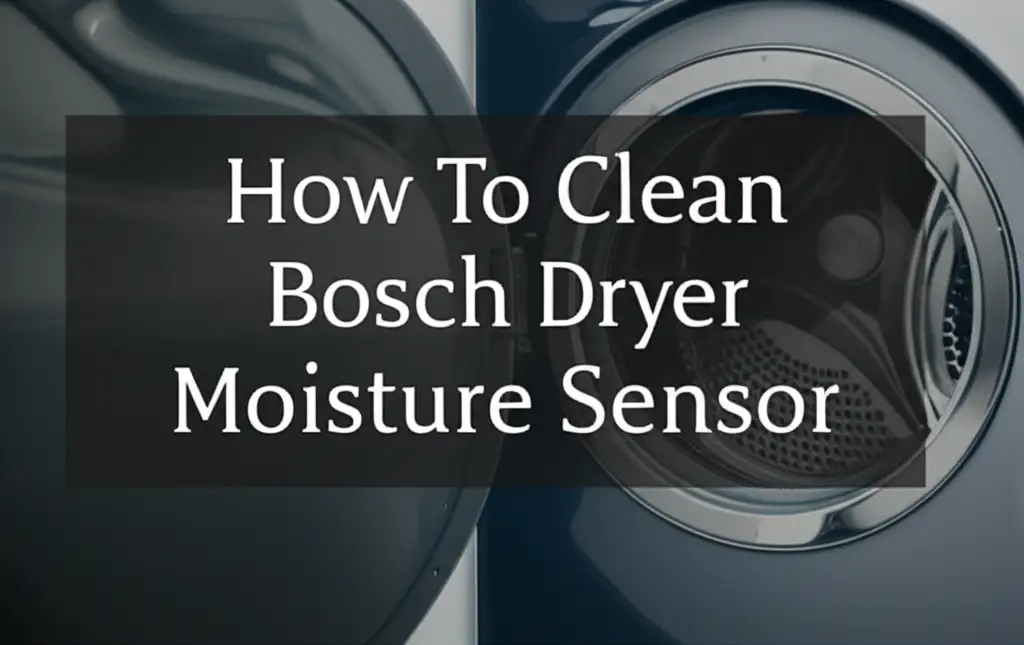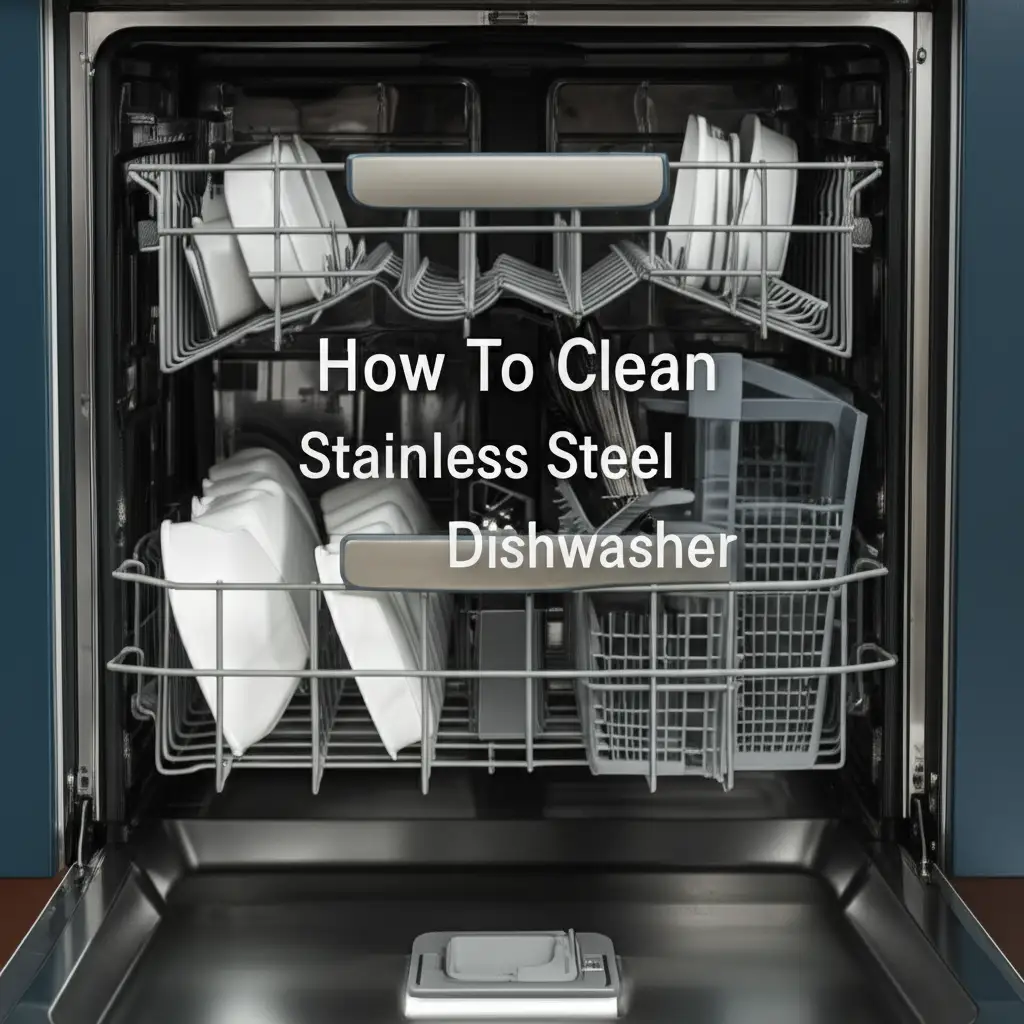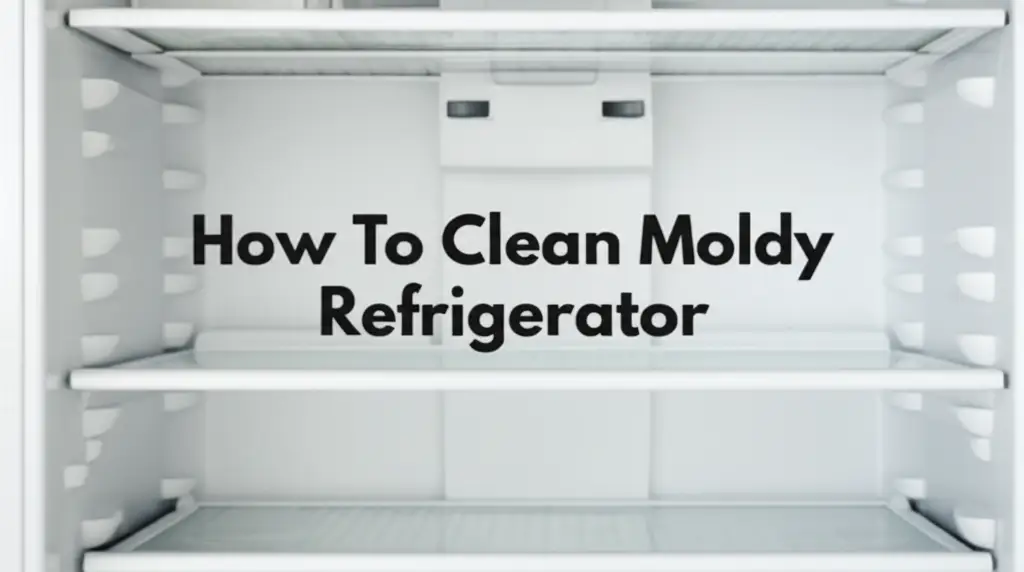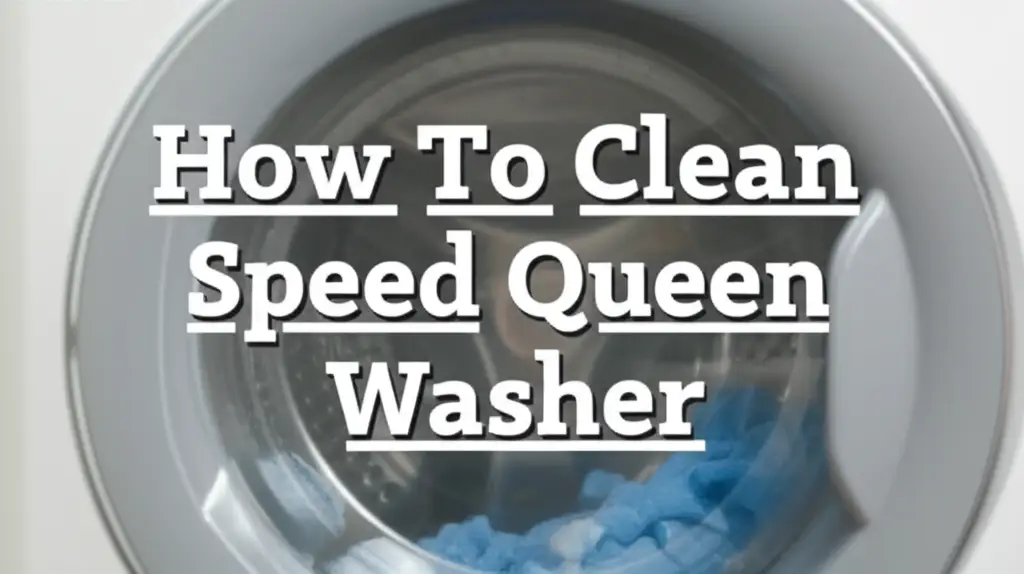· Appliance Care · 11 min read
How To Clean Bosch Dryer Moisture Sensor

Optimize Your Bosch Dryer: Cleaning the Moisture Sensor
Do your clothes come out of the dryer still damp, or perhaps bone-dry and wrinkled? This common problem often points to a single, overlooked culprit: your dryer’s moisture sensor. This tiny but mighty component helps your Bosch dryer detect when your laundry is dry, signaling it to stop. A dirty sensor cannot do its job properly. I will guide you through the process of how to clean your Bosch dryer moisture sensor. This will restore its accuracy and get your laundry perfectly dry every time.
Takeaway:
- Regularly clean your Bosch dryer’s moisture sensor to maintain optimal drying performance.
- Use isopropyl alcohol and a microfiber cloth for effective, safe cleaning.
- Always unplug the dryer before beginning any maintenance.
- Cleaning the sensor prevents over-drying, under-drying, and saves energy.
To effectively clean a Bosch dryer moisture sensor, first unplug the appliance for safety. Locate the two metal sensor bars, usually inside the dryer drum near the lint trap. Gently wipe these bars with a microfiber cloth dampened with isopropyl alcohol, removing any lint, fabric softener residue, or dirt. This restores accurate moisture detection.
Understanding Your Bosch Dryer Moisture Sensor
Your Bosch dryer is a smart appliance. It uses technology to dry your clothes efficiently. A key part of this technology is the moisture sensor. This sensor is crucial for preventing both under-drying and over-drying of your laundry.
The moisture sensor system consists of two metal strips or bars. These bars sit inside the dryer drum. As clothes tumble, they make contact with these strips. The dryer sends a small electrical current between the strips. Wet clothes conduct electricity better than dry clothes. The sensor measures how much current passes between the bars. When the current drops below a certain point, the dryer knows the clothes are dry. It then stops the drying cycle. This saves energy and protects your clothes. A dirty sensor cannot accurately read the moisture levels. This leads to inefficient drying cycles. Understanding how this sensor works helps you appreciate the importance of keeping it clean.
Why Your Bosch Dryer Moisture Sensor Needs Cleaning
You might wonder why a simple sensor needs regular attention. Over time, lint, fabric softener residue, and even detergent particles build up on the sensor bars. These substances create an insulating layer on the metal strips. This layer stops the sensor from accurately detecting moisture.
When the sensor is dirty, it thinks your clothes are dry sooner than they actually are. This leads to frustratingly damp laundry. Conversely, it might never register the clothes as dry, causing the dryer to run for too long. This wastes energy and can damage your clothes through excessive heat. Imagine pulling out still-damp towels or crisp, shrunken sweaters. A dirty sensor is usually the reason. Regular cleaning maintains the sensor’s ability to “feel” the moisture. This ensures your dryer operates as intended. This simple maintenance step makes a big difference in your laundry routine.
Gathering Your Tools for Sensor Cleaning
Before you start cleaning, gather the right tools. Having everything ready makes the job easy. You do not need many items. The items you need are simple and easy to find.
Here is a list of what you will need:
- Microfiber cloths: These are soft and non-abrasive. They will not scratch the sensor bars. Have a couple on hand.
- Isopropyl alcohol (rubbing alcohol): This is the best cleaning agent for sensors. It evaporates quickly and leaves no residue. It is safe for electronic components. Avoid using water or harsh chemicals.
- Flashlight (optional but recommended): This helps you see clearly inside the dryer drum. The drum can be dark, and a flashlight illuminates the sensor’s exact location.
- Screwdriver (rarely needed): Most Bosch dryer sensors are easily accessible. However, some models might require removing a panel for better access. Check your dryer manual if you struggle to locate the sensor.
Always make sure your cleaning cloths are clean themselves. A dirty cloth can add more grime to the sensor. Preparing your tools beforehand ensures a smooth and effective cleaning process. This preparation also prevents damage to the dryer.
Step-by-Step Guide to Cleaning the Moisture Sensor
Cleaning your Bosch dryer moisture sensor is a straightforward process. You must follow these steps carefully. Safety is the most important thing. Always put safety first before starting any appliance maintenance.
Step 1: Prioritize Safety – Unplug Your Dryer
Before touching any part of your dryer, unplug it from the wall outlet. This step is critical. It eliminates any risk of electrical shock. Do not skip this step, even if you think the dryer is off. The power cord must be completely disconnected from the power source. This ensures your safety throughout the cleaning process. I always double-check that the plug is out. This peace of mind is worth the extra second.
Step 2: Locate the Moisture Sensor Bars
Open your dryer door. Look inside the dryer drum. You will typically find the moisture sensor bars near the lint trap. They are usually two thin, parallel metal strips. These strips are often located on the dryer drum’s front bulkhead, just below the drum opening. Some Bosch models might have them on the back wall of the drum. Use your flashlight if needed to get a clear view. They stand out against the white or gray interior of the drum. They might appear slightly discolored or coated with residue.
Step 3: Gently Clean the Sensor Bars
Now it is time for the actual cleaning. Dampen one of your microfiber cloths with isopropyl alcohol. Make sure it is damp, not soaking wet. Gently wipe the entire surface of both metal sensor bars. Apply light pressure. You want to remove any visible lint, fabric softener buildup, or other grime. You might notice the cloth picking up a lot of dark residue. This confirms the sensor was indeed dirty. Repeat this process with a clean part of the cloth or a new damp cloth until no more residue comes off. Do not use abrasive scrubbers or harsh chemicals. These can damage the sensor’s delicate surface. The goal is to restore the bare metal’s conductivity.
Step 4: Allow to Dry and Reassemble
After cleaning, let the sensor bars air dry completely. Isopropyl alcohol evaporates quickly. This usually takes only a few minutes. Ensure there is no moisture left on the sensor. Once dry, you can plug your dryer back into the wall outlet. Close the dryer door. Your Bosch dryer is now ready for a test run. This simple cleaning can significantly improve your dryer’s performance.
Testing Your Bosch Dryer After Cleaning
After cleaning the moisture sensor, it’s a good idea to test your dryer. This helps you confirm that the cleaning worked. You will immediately notice a difference in performance. This test confirms the sensor is working correctly again.
Load your dryer with a small to medium load of damp laundry. Choose items that take a moderate amount of time to dry. Select an automatic drying cycle, such as “Sensor Dry” or “Cottons Auto Dry.” Do not use a timed dry setting for this test. The automatic cycle relies on the moisture sensor. Pay attention to how long the dryer runs. It should stop when the clothes are perfectly dry, not damp or over-dried. If your clothes come out dry and without wrinkles, your sensor cleaning was successful. If issues persist, consider repeating the cleaning process. Sometimes, stubborn buildup needs a second pass.
For other dryer cleaning challenges, like when something spills inside the drum, you might find helpful guides such as how to clean gum out of a dryer or how to clean crayon out of dryer. These problems can also affect overall dryer performance.
Maintaining Your Dryer for Long-Term Efficiency
Cleaning the moisture sensor is a vital part of dryer maintenance. However, it is just one piece of the puzzle for long-term efficiency. Several other practices help keep your Bosch dryer running at its best. Regular maintenance extends your appliance’s life. It also keeps energy bills down.
First, always clean your lint filter after every load. A clogged lint filter restricts airflow. This makes your dryer work harder and longer. It is also a fire hazard. Second, periodically inspect and clean your dryer vent. Lint can accumulate in the vent duct. This reduces efficiency and poses a fire risk. You can use a dryer vent cleaning kit for this. If you need to clean your dryer vent from the outside, there are specific tools and methods. For example, you might look into how to clean dryer vent from outside with drill. This helps ensure maximum airflow.
Third, avoid overfilling your dryer. Overloading prevents proper air circulation. Clothes dry unevenly and take longer. Fourth, use the correct dryer settings for your fabric types. This protects clothes and optimizes drying time. Finally, perform a deep cleaning of the dryer drum periodically. This removes residue that can transfer to clothes or affect sensors. By following these steps, your Bosch dryer will serve you well for many years. Regular upkeep prevents most common dryer problems.
Troubleshooting Common Bosch Dryer Issues
Even with regular cleaning, you might encounter other issues with your Bosch dryer. Many problems have simple solutions. Knowing common troubleshooting steps saves you time and money. It also helps you determine if a professional is needed.
If your clothes are still not drying completely after sensor cleaning, check the lint filter again. Ensure it is completely free of lint. Next, inspect the dryer vent hose for kinks or blockages. A restricted vent is a very common cause of long drying times. Make sure the vent is not crushed behind the dryer. Also, check the circuit breaker. Sometimes, one leg of the 240V power supply to the dryer can trip, causing it to heat slowly or not at all. You might also notice if the clothes are just warm, not hot.
Another potential issue is a faulty heating element. If the dryer runs but produces no heat, the element might need replacement. This usually requires professional help. Unusual noises could indicate a worn belt or motor issue. Refer to your Bosch dryer’s user manual for specific error codes or troubleshooting steps unique to your model. Remember, a clean sensor is foundational. If you have a different brand, like a Samsung dryer, the steps for sensor cleaning are very similar, as seen in guides like how to clean moisture sensor on Samsung dryer. This shows that good maintenance practices apply across various appliances.
FAQs About Bosch Dryer Moisture Sensors
How often should I clean my Bosch dryer moisture sensor?
You should clean your Bosch dryer moisture sensor every three to six months. If you use a lot of fabric softener, clean it more often, perhaps monthly. Fabric softener residue builds up quickly. Frequent cleaning maintains optimal drying performance and energy efficiency.
Can I use water to clean the moisture sensor?
No, do not use water to clean the moisture sensor. Water can cause rust or leave mineral deposits on the metal strips. This can further impede the sensor’s function. Always use isopropyl alcohol for effective and safe cleaning. Isopropyl alcohol evaporates quickly and leaves no residue.
What happens if I don’t clean the moisture sensor?
If you do not clean the moisture sensor, it will accumulate lint and fabric softener residue. This buildup creates an insulating layer. The sensor cannot accurately detect moisture levels. This leads to your clothes either being over-dried or remaining damp, increasing energy consumption and laundry time.
Where exactly are the moisture sensors located in a Bosch dryer?
In most Bosch dryers, the moisture sensors are two small, parallel metal strips. They are usually found inside the dryer drum. Look for them on the front bulkhead, just below the dryer opening and often near the lint trap. Some models might have them on the back wall of the drum.
Will cleaning the sensor fix all my dryer problems?
Cleaning the moisture sensor will fix problems related to inaccurate drying times and unevenly dried clothes. However, it will not fix issues like no heat, strange noises, or error codes unrelated to moisture sensing. Always check other common causes like clogged lint filters or blocked dryer vents for complete troubleshooting.
What if my dryer still isn’t drying properly after cleaning the sensor?
If your dryer still has drying issues after cleaning the sensor, check other components. Inspect the lint filter for blockages and ensure the dryer vent is clear and unobstructed. A clogged vent is a common cause of poor drying. Also, verify that the heating element is working. If problems persist, consider contacting a professional appliance technician for further diagnosis.
Conclusion
Cleaning your Bosch dryer moisture sensor is a simple yet incredibly effective maintenance task. It directly impacts your dryer’s performance and longevity. By following these easy steps, you ensure your appliance dries clothes efficiently and accurately every time. This saves you energy and prevents damage to your favorite garments.
I encourage you to make this a regular part of your home maintenance routine. A clean sensor means perfectly dry clothes, less frustration, and a more efficient laundry day. Take a few minutes today to give your Bosch dryer the attention it deserves. Your clothes, and your energy bill, will thank you. Get ready for perfectly dry laundry, every single cycle.
- Bosch dryer
- moisture sensor
- dryer cleaning
- appliance maintenance
- drying efficiency




